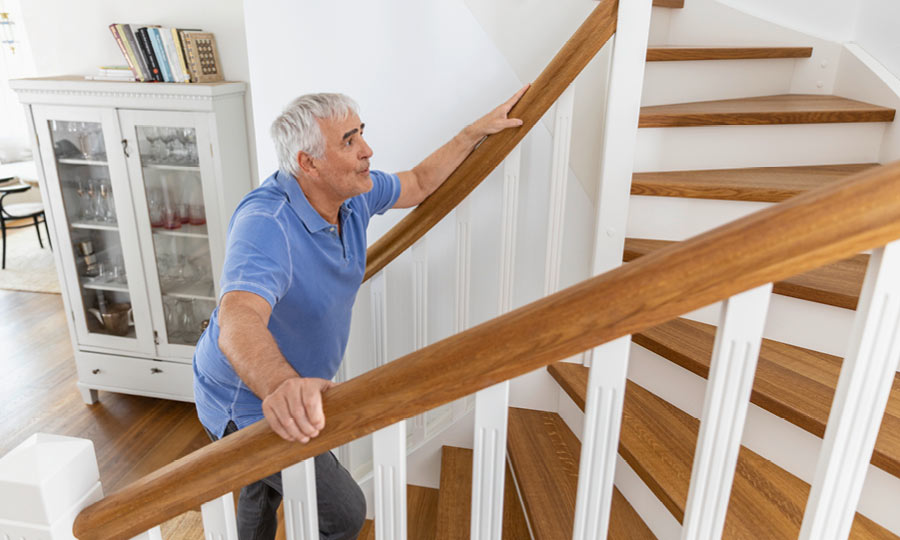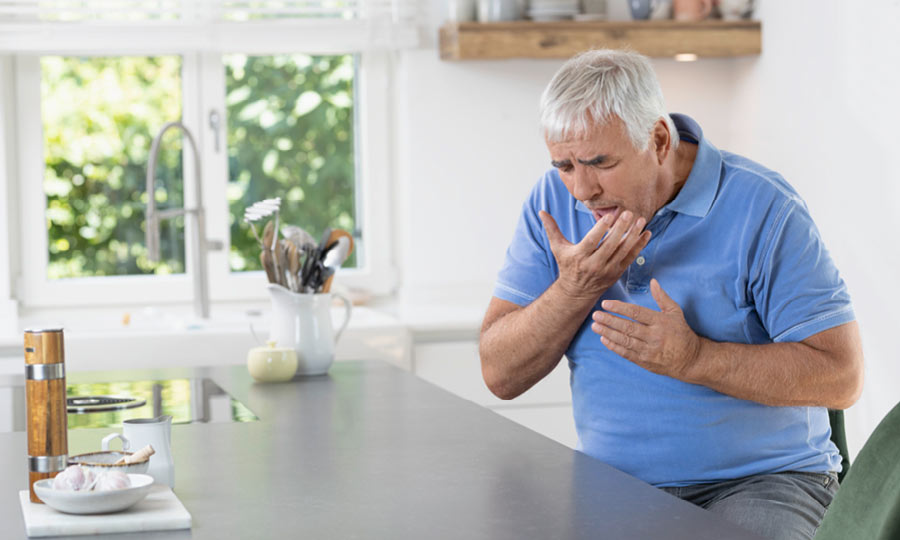Chronic obstructive pulmonary disease (COPD) affects millions of people in Germany. To date, there is no cure for COPD, but there are treatment options. Read here for everything you need to know about the symptoms, causes, diagnosis and treatment of COPD.
COPD stands for chronic obstructive pulmonary disease. With COPD, the airways are constantly (chronically) inflamed and obstructed. The disease is progressive and irreversible. COPD cannot be cured and damage to the lungs is irreversible. But with the right treatment, it is possible to slow down its progression and to ease the symptoms. What is important is early diagnosis and avoiding risk factors, such as smoking.

The primary cause of COPD is smoking. Over the years, tobacco smoke damages the cilia and mucous membranes of the airways, thereby accelerating the normal ageing process of the lungs. Around 10-20% of people with COPD have never smoked1.
The triad of symptoms of COPD are sputum, cough and shortness of breath. These symptoms tend to be mild initially, which is why they are not taken seriously and are confused with a respiratory infection. COPD is divided into different stages, known as GOLD stages.
Symptoms at this stage are usually so mild that COPD is not even recognised yet. The cough tends to be mild and only in the mornings. Typically, though, the cough is productive with sputum. Patients often interpret these symptoms as a persistent respiratory tract infection.
At GOLD stage II, the symptoms tend to be slightly more pronounced. The cough with sputum often continues throughout the day. Patients may also find that physical exertion leaves them short of breath. If patients are physically inactive or avoid physical activity because of their shortness of breath, they may not even notice the deterioration. However, usually at this stage the first seek for medical treatment occurs.
The symptom triad of sputum, cough and shortness of breath are at this point evident even during day-to-day activities. Patients have more frequent infections and exacerbations (acute deteriorations in state of health). Lung function is generally already very restricted at this stage. Daily life is increasingly difficult and this results in a loss of quality of life.
Many patients have symptoms even if they are resting and suffer from shortness of breath just by doing light everyday activities. Often, they cannot manage their daily routines alone and are dependent on support. At this stage, some already need treatment with oxygen.

The precise diagnosis of COPD requires a thorough assessment by a specialist. This includes pulmonary function tests, a comprehensive medical history and sometimes also imaging procedures. Unfortunately, the disease is all too often not diagnosed until the late stages, because that is when patients really find themselves severely hampered by their symptoms.
If you have noticed that you or an elderly relative has a cough with sputum that persists for months and months, it is better to err on the side of caution and speak to your lung specialist or GP.
While COPD cannot be cured, it can be treated. Treatment can be divided into drug therapy and non-pharmaceutical therapy.
Drug therapy of COPD is designed to alleviate or prevent symptoms, reduce the frequency and severity of exacerbations (sudden deteriorations in state of health) and improve quality of life. The medication is always prescribed by the attending physician and should not be changed by the patient.
In most cases, COPD drugs are inhaled. This means that the drug reaches the place it needs to take effect - i.e., the lungs. A smaller dose is needed to achieve the desired effect than with systemic administration (such as tablets) - providing, that the right inhalation technique is used.
Bronchodilators are drugs that dilate the bronchi and so reduce shortness of breath. They are a basic medication for COPD. That means that almost every patient with COPD will have these in their treatment regimen. Bronchodilators are also important for COPD to reduce hyperinflation of the lungs, a typical symptom in COPD2.
Most people will have heard of cortisone. These drugs are anti-inflammatory and so are designed to reduce the incidence and severity of exacerbations. These anti-inflammatory drugs are usually prescribed to patients with an increased numbers of eosinophil cells in the blood. If ICS are inhaled through a metered-dose aerosol (spray), it may make sense to use a holding chamber (spacer) to avoid side effects such as fungal infections in the mouth and throat.
The best treatment for COPD is prevention. Tobacco smoke is the greatest risk factor for COPD. Giving up smoking is the most efficient and cost-effective measure to prevent COPD or to slow down its progression. Many health insurance companies offer programmes to help you quit smoking.
Unfortunately, many patients with the symptom triad of COPD, which initially only makes itself felt during physical exertion, will respond by becoming inactive rather than seeing their doctor. Avoiding symptoms by being inactive is an unhealthy vicious circle, as the benefits of physical training for COPD are well known3. Patients are advised to consult their doctor on this subject.
Respiratory therapy is targeted at easing shortness of breath at rest and during physical exertion. Other therapy goals are transporting mucus out of the bronchi and easing the cough. PEP (positive expiratory pressure) therapy can also be used3. This is where the patient exhales against positive pressure or resistance. The PARI PEP S System can be combined with inhalation to save time. Oscillating PEP devices such as the PARI O PEP can also support clearance of mucus4.
Inhaling isotonic saline solution with a nebuliser moistens the mucous membranes5 and can help prevent respiratory infections by supporting the self-clearing function of the airways (mucociliary clearance)5. It is crucial to prevent airway infections as these can lead to exacerbations (sudden flare-ups). Inhaling hypertonic saline solutions supports the clearance of mucus from the bronchi.
COPD is a chronic and progressive disease of the lungs. There is no cure to date. Early diagnosis and treatment can slow down disease progression. Unfortunately, patients are often not diagnosed until they are in the late stages. If you have noticed that you or an elderly relative has the typical triad of COPD symptoms (sputum, cough, shortness of breath) that persist for a long time, it is better to err on the side of caution and visit a lung specialist.
Treatment of COPD is targeted at easing symptoms and improving quality of life. Those affected can do more than just drug therapy. It is particularly important to give up smoking and start a special (lung) sports programme. We believe that inhaling saline solution to prevent respiratory infections and improve mucus clearance, is an important add-on treatment for COPD.
References
[1] https://www.lungeninformationsdienst.de/krankheiten/copd/risikofaktoren
[2] https://www.lungeninformationsdienst.de/krankheiten/copd/therapien
[3] https://register.awmf.org/assets/guidelines/020-006l_S2k_COPD_chronisch-obstruktive-Lungenerkrankung_2018-01.pdf
[4] https://register.awmf.org/assets/guidelines/nvl-003l_S3_COPD_2021-09.pdf
[5] https://www.lungenaerzte-im-netz.de/news-archiv/meldung/einfaches-inhalieren-kann-die-ansteckungsgefahr-mit-coronaviren-deutlich-senken/
Contact us
Any questions? You can reach our service center at this number:
+49 8151 279-5220
© 2025 PARI GmbH Spezialisten für effektive Inhalation